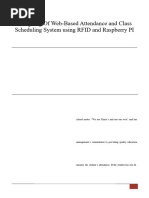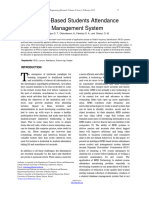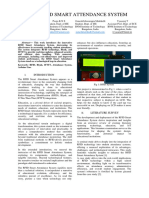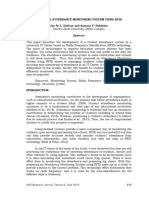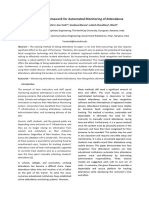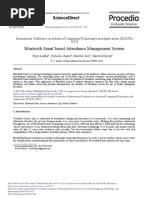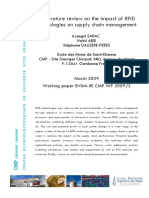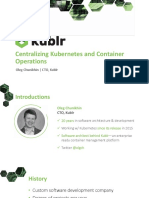Lyceum of The Philippines University - Laguna Student Electronic Attendance and Logging System (Lpu-Laguna Seals)
Lyceum of The Philippines University - Laguna Student Electronic Attendance and Logging System (Lpu-Laguna Seals)
Uploaded by
Renz SoledadCopyright:
Available Formats
Lyceum of The Philippines University - Laguna Student Electronic Attendance and Logging System (Lpu-Laguna Seals)
Lyceum of The Philippines University - Laguna Student Electronic Attendance and Logging System (Lpu-Laguna Seals)
Uploaded by
Renz SoledadOriginal Title
Copyright
Available Formats
Share this document
Did you find this document useful?
Is this content inappropriate?
Copyright:
Available Formats
Lyceum of The Philippines University - Laguna Student Electronic Attendance and Logging System (Lpu-Laguna Seals)
Lyceum of The Philippines University - Laguna Student Electronic Attendance and Logging System (Lpu-Laguna Seals)
Uploaded by
Renz SoledadCopyright:
Available Formats
LPU-Laguna Journal of Multidisciplinary Research
Vol. 4 No.3 September 2015
LYCEUM OF THE PHILIPPINES UNIVERSITY – LAGUNA
STUDENT ELECTRONIC ATTENDANCE AND
LOGGING SYSTEM (LPU-LAGUNA SEALS)
Isaac M. Morallo
College of Engineering and Computer Studies
Lyceum of the Philippines – Laguna
ABSTRACT
This study was developed to create an electronic attendance and logging
system using Radio Frequency Identification (RFID) and Short Messaging
Service (SMS) with a Web-based management system portal that allows
user to access real time data to ensure campus security and smart
information management. The students will use RFID card system to check
in and out of the main entrance, to both track attendance and log time and
prevent unauthorized entrance therefore utilize the RFID technology. The
LPU-LAGUNA SEALS system developed in this study has six main functions:
(1) to use the student RFID chip in the ID’s as gate pass, (2) to send daily
SMS to parents about the student entry and exit time record, (3) to efficiently
manage and monitor student attendance and logs thru intranet and internet,
(4) to integrate Web-based system portal to access real time logs and
attendance, (5) to provide printed reports and electronic files of attendance
and logs, and (6) and implement the system in Lyceum of the Philippines –
Laguna. This program was designed and developed using various
programming languages and technologies such as Visual Basic 2010 (VB
.NET), Hypertext Mark-up Language 5 (HTML5), Cascading Style Sheet 3
(CSS3), Hypertext Pre-processor (PHP) scripting language, JQuery, MySQL
database engine, RFID and GSM (Global System for Mobile) module. This
system is implemented at the main gate of LPU-Laguna using client-server
technology which comprises the reader, the tag, the GSM module, a client
PC and a database server. The researcher applied Rapid Application
Development (RAD) method as the system framework model that focuses on
the system development utilizing prototypes thereby flexibly adjusting
requirements as the need arises. The system was successfully implemented
by utilizing the use of both RFID and SMS technology in the process which
resulted in an efficient monitoring and managing of attendance and logs of
the students that provides campus security and efficient information
management.
Research and Statistics Center LPU-Laguna
LPU-Laguna Journal of Multidisciplinary Research
Vol. 4 No.3 September 2015
Keywords: Radio frequency identification, electronic attendance,
electronic logs, logging system, short messaging.
INTRODUCTION
Today, software is an essential way and innovative solution through
which most of the organizations whether private or public use in their system
processes to have an efficient and effective information management.
Furthermore, the integration of the Radio Frequency Identification (RFID)
technology in various system processes is widely used nowadays to build a
smart system that can be used for effective identification, monitoring and
security of data. In fact, the study of Arulogun et al. (2013) affirms that RFID
is not a new technology and consequently constitutes system integration
because of its low cost and feature advances in various computing fields that
open up other application assimilation. In fact, RFID technology is the
medium used by students‘ in LPU-Laguna as identification card.
Consequently, time and attendance tracking are important factors of an
effective organizational performance and management.
The Lyceum of the Philippines – Laguna is currently using a
Student Monitoring System using the low frequency RFID technology to keep
track of the student entry and exit within the school premises. However, the
system is not fully utilized because of the current system limitations. For
example, the system does not support a client server technology and only
uses a stand-alone database that poses inefficient retrieval and
management of data. This process is time consuming, tedious and laborious
because the administrator constantly access the data using flash drive in the
stand-alone database server. Furthermore, the Short Messaging System
(SMS) functionality is not functional hence it does not provide data utilization
primarily to notify parents of the student entry and exit in the campus and
their where about. This problem is worthy of consideration because all
Research and Statistics Center LPU-Laguna
LPU-Laguna Journal of Multidisciplinary Research
Vol. 4 No.3 September 2015
parents and administrator are always concerned and worry about their
student attendance, tendency of cutting classes, safety and where about of
the students. In addition to these problems, strict implementation of the ―no
identification no entry‖ policy and riddling of unauthorized entry in the
campus concerns the administration and provide careful consideration.
By careful consideration of the above problems, the researcher
conducted this study to fully utilize the use of RFID, client-server technology
and SMS technology to efficiently and effectively manage and monitor the
attendance and logging of the students once they enter and leave the school
premises and thereby ensures student safety and where about in real time
thus give the parents information about the presence of their student in
school. Furthermore, the system has the capability of providing printed and
electronic reports of students‘ attendance for specific purposes. The system
will fully utilize client-server technology using a central database server that
will serve as the core of the system that maximizes the accessing of data
effectively. Hence, the system has an online system portal that can be
accessed by different departments to post specific announcements to
students‘ made visible at the entrance television screen once they tap their
RFID. Moreover, the online system portal provide parents, faculty and
various departments login access where they can access student real time
logs, post messages and announcements directed to a particular student to
call their attention.
Conceptual Framework
The researcher used input-process-output (IPO) model as shown in
Figure 1 as a guiding tool hence the electronic attendance and logging
system was developed. The input contains the knowledge in software
development, knowledge in hardware and Information Technology
Research and Statistics Center LPU-Laguna
LPU-Laguna Journal of Multidisciplinary Research
Vol. 4 No.3 September 2015
infrastructure, knowledge in optimizing the RFID, SMS and client-server
technology, knowledge in attendance and logging management, Web-based
application development and database design.
INPUT PROCESS OUTPUT
Knowledge in software Identify the requirements
development
Analyze and design the
Knowledge in hardware and system
IT infrastructure
Develop the software
Knowledge in utilizing RFID,
SMS and client-server LPU-Laguna – Student
Test the system
technology functionalities Electronic Attendance
and Logging System
Knowledge in attendance and Implement the system (LPUL-SEALS)
logging system
Knowledge in Web-based
application and database
design
Figure 1. Developmental framework
Objectives of the Study
The study was designed and developed to create an electronic
attendance and logging system in Lyceum of the Philippines – Laguna using
RFID and SMS with a Web-based management portal that allows user to
access real time data, ensure campus security and information
management.
The specific objective of the LPU-LAGUNA SEALS development is
to:
1. use the student RFID chip in the ID‘s as gate pass;
2. send daily SMS to parents about the student campus entry
and exit time record;
3. efficiently manage and monitor student attendance and logs
thru intranet and online;
Research and Statistics Center LPU-Laguna
LPU-Laguna Journal of Multidisciplinary Research
Vol. 4 No.3 September 2015
4. integrate online system management portal to post
messages and access real time logs and attendance;
5. provide database generated printed reports and electronic
files of attendance and logs; and,
6. implement the system in Lyceum of the Philippines –
Laguna.
METHODOLOGY
Research Design
The researcher has used the Rapid Application Development
(RAD) shown in Figure 2 as the method of developing the system. The RAD
method is a system process model that focuses primarily on the system
development portion thereby utilizing the use of prototypes and therefore
adjusting requirements as the need may arise.
Building from this method, the researcher takes full advantage of
this powerful and agile application development tool to develop the project
rapidly without compromising the systems inclusive quality. Furthermore,
prototyping is used to help intended users visualize and request changes to
the system as it is being built thus allowing applications to evolve
incrementally and iteratively.
BUILD
ANALYSIS AND IMPLEMENTATION
DEMONSTRATE TESTING
QUICK DESIGN
DESIGN
Figure 2. Rapid Application Development Process.
Research and Statistics Center LPU-Laguna
LPU-Laguna Journal of Multidisciplinary Research
Vol. 4 No.3 September 2015
Moreover, the RAD structure lifecycle is carefully considered and
applied to ensure that the researcher builds the system and its needed
technology to meet what the users really need and the system functions
offered. In effect, this methodology lifecycle through the four stages includes
all of the activities and tasks required to scope and define business and
necessary requirements to design, develop, and implement the application
system that supports those requirements in order to finish the system and
provide the necessary improvements.
Research Development Process
The development process step by step procedure is presented as
shown in Figure 3. The process follows the identification of the
developmental research objectives, then following the analysis of the system
requirements, constraints, features and functionalities and then followed by
the design stage. The succeeding part is the actual development of the
system after which a series of tests was conducted to ensure that the overall
system features and functionalities were met.
Identify the Analyze and Design Develop the System
Objectives the System
Deployment of the Test the Entire
System System
Figure 3. Flowchart of the project activities
RESULTS AND DISCUSSION
The LPU-LAGUNA-SEALS utilizes the use of RFID, SMS and
client-server technology to meet the required system functionalities.
Research and Statistics Center LPU-Laguna
LPU-Laguna Journal of Multidisciplinary Research
Vol. 4 No.3 September 2015
According to the study of Zedally et al. (2009) RFID technology is moving
rapidly from a limited number of applications to many new areas of
applications.
A. The RFID
Figure 4. The Radio Frequency Identification Flow
The RFID is an acronym for "radio-frequency identification" and
usually refers to a technology whereby digital data encoded in RFID tags
captured by a reader via radio waves as clearly shown in Figure 4.
Moreover, according to the study of Wyld (2006) the RFID is an emerging
and widely applied technology that is forecasted to grow exponentially in use
over the next decade. The RFID which uses radio waves to identify objects is
projected to rapidly supplant bar code technology as the principal means of
identifying items in the supply chain and in a wide variety of applications.
This explicit overview of the fundamentals of RFID and the technological
knowledge and skills of the researcher gives motivation and impetus to
diligently endeavor to finish this research.
Research and Statistics Center LPU-Laguna
LPU-Laguna Journal of Multidisciplinary Research
Vol. 4 No.3 September 2015
B. The Server, Client, RFID Reader and SMS
Online
Portal
TV
Monitor
Database Server
Server PC
Client PC
TV
Monitor
Figure 5. The System Architecture.
The diagram as shown in Figure 5 is the actual setup of the system
and explains how the system interacts and functions collectively in the
infrastructure. The RFID reader is connected to the client computer which
retrieves the data from the database server once the RFID taps in the
reader. The system validates the input data by checking and comparing the
student identification with the RFID code and after a match is found the
information is sent back to the client which then be displayed in the television
monitor screen. Furthermore, an SMS message will be sent automatically to
the cellphones of the parents that is registered in the system once the RFID
taps into the system. The report of attendance and logs is also available at
Research and Statistics Center LPU-Laguna
LPU-Laguna Journal of Multidisciplinary Research
Vol. 4 No.3 September 2015
the system server and in the online system portal upon validation of the user
login to the server and online portal.
CONCLUSION
The researcher created an electronic attendance and logging
system with the utilization of RFID as students‘ gate pass and SMS with an
integration of online management portal and client-server technology with a
database server that provides reliability and security of data.
The system sends daily SMS to parents about the database
generated student log-in and log-out time recorded by integrating GSM
module and hence the students‘ attendance and logs is efficiently manage
and monitored.
The system has incorporated ubiquitous online system
management portal accessed by the different departments where they can
post and view messages and announcements. Moreover, parents can readily
access attendance and logs in real time in the online system portal using
their personal login accounts.
The program provides flexible real time reports of attendance and
logs of the students in electronic copy and printed copy format which
enhances the system functionality and utilization that helps the institution in
information dissemination and management.
The system is implemented in Lyceum of the Philippines – Laguna.
Research and Statistics Center LPU-Laguna
LPU-Laguna Journal of Multidisciplinary Research
Vol. 4 No.3 September 2015
RECOMMENDATION
The researcher recommends to evaluate the effectiveness of the
system using the ISO 9126 model or the Hewlett-Packard model in terms of
system performance, functionality, usability, reliability and extensibility.
Moreover, the researcher also recommends the use and integration
of turnstile in the system. Hence, the system was developed to ensure
security and to track unauthorized entry at the gate entrance it is therefore
imperative to recommend to the future researchers to incorporate turnstile
into the system that will hold the RFID tag so that campus security will be
enhanced.
REFERENCES
Arulogun, O. T., Olatunbosun, A., Fakolujo, O. A., & Olaniyi, O. M. (2013).
RFID-Based Students Attendance Management
System. International Journal of Scientific & Engineering
Research, 4(2).
Calvet, J. C. L. (2005). The role of RFID in the mobile phone. Telektronikk,
101(3/4), 131.
Chandrashekar R., Shinde J., Dashrath M. (2013). Importance and Analysis
of RFID in Student Attendance. International Journal of Emerging
Science and Engineering (IJESE) ISSN: 2319–6378, Volume-1,
Issue-9,
Dellosa M. R. (2011). Development of Student Monitoring System with the
Use of Low Frequency Radio Frequency Identification (RFID) and
Short Messaging System.
10
Research and Statistics Center LPU-Laguna
LPU-Laguna Journal of Multidisciplinary Research
Vol. 4 No.3 September 2015
Gragg, J. (2003). The emergence of RFID technology in modern society.
Oregon State University.
Gupta A., Jagdish L. R., Nayak S., (2009). Rfid Based Networked Gate Entry
Control System (GECS). International Journal of Computer Networks
& Communications (IJCNC), Vol.1, No.3.
Parvathy, A., Raj, V. R., & Reddy, M. (2011). RFID based exam hall
maintenance system. IJCA Special Issue on “Artificial Intelligence
Techniques-Novel Approaches & Practical Applications” AIT.
Sheng, Q. Z., Li, X., & Zeadally, S. (2008). Enabling Next-Generation RFID
Applications: Solutions and Challenges. IEEE Computer, 41(9), 21-
28.
Wyld, D. C. (2006). RFID 101: The next big thing for management.
Management Research News, 29(4), 154-173.
Zeadally S., Li X., Sheng Q., (2008). Enabling Next-Generation RFID
Applications: Solutions and Challenges. Journal Published by the
IEEE Computer Society, September 2008.
11
Research and Statistics Center LPU-Laguna
You might also like
- Students Attendance Management System DaDocument46 pagesStudents Attendance Management System DaHafiz AbduNo ratings yet
- Lpu L Student Electronic Attendance and Logging System Lpu Laguna SealsDocument11 pagesLpu L Student Electronic Attendance and Logging System Lpu Laguna SealsMariel RebambaNo ratings yet
- Local LiteratureDocument2 pagesLocal LiteratureTracy AnneNo ratings yet
- Designing Web Based AttendanceDocument8 pagesDesigning Web Based AttendanceChumayyo GelanNo ratings yet
- RFID Students Attendance Management SystDocument9 pagesRFID Students Attendance Management Systnhatkhoa03xNo ratings yet
- LOCAL LITERATURE (Tracy)Document2 pagesLOCAL LITERATURE (Tracy)Tracy AnneNo ratings yet
- Several Procedures Are ImprovedDocument3 pagesSeveral Procedures Are Improvedkarijsd08No ratings yet
- Chapter 1Document9 pagesChapter 1Rukio GamingNo ratings yet
- Visitors Log Monitoring System For BJMP Capstone ProjectDocument8 pagesVisitors Log Monitoring System For BJMP Capstone ProjectPlacid Ity50% (4)
- Finolex Academy of Management and TechnologyDocument35 pagesFinolex Academy of Management and TechnologyRenuka SawantNo ratings yet
- Attendance Control System Based RfidDocument4 pagesAttendance Control System Based Rfidhenryaaron_10No ratings yet
- Grace Corrected 1Document48 pagesGrace Corrected 1Ossai IsraelNo ratings yet
- ContentsDocument4 pagesContentsJinuichi GolibamNo ratings yet
- Capstone ProposalDocument9 pagesCapstone ProposalgmccruzNo ratings yet
- Ieee Finalcopy 12thDocument5 pagesIeee Finalcopy 12thPooja KarnamNo ratings yet
- CCI-RFID Student Monitoring System With Web AppsDocument39 pagesCCI-RFID Student Monitoring System With Web AppsSarmiento B. Fred100% (1)
- It Center Attendance Monitoring System Using RF IdDocument11 pagesIt Center Attendance Monitoring System Using RF Idorekihoutaro252004No ratings yet
- School of Technology: Marinduque State CollegeDocument2 pagesSchool of Technology: Marinduque State CollegeAnonymous tSMHrc5jNo ratings yet
- Student Database Management and Enquiry System Using Barcode Scanner 1403Document13 pagesStudent Database Management and Enquiry System Using Barcode Scanner 1403shalini singhNo ratings yet
- Automated Attendance System Using NFCDocument8 pagesAutomated Attendance System Using NFCEddytech PioneerNo ratings yet
- BC Rfid 4.0Document27 pagesBC Rfid 4.0Rodge PastoralNo ratings yet
- PRJ ReporthinduDocument40 pagesPRJ ReporthinduHindu PriyaNo ratings yet
- Student Smart Card: Mr. Pratik M. Sonar Mr. Sourabh S. Walke Prof. Raman R. BaneDocument5 pagesStudent Smart Card: Mr. Pratik M. Sonar Mr. Sourabh S. Walke Prof. Raman R. Banekeerthika PeravaliNo ratings yet
- 05+icmdrse 2023 Mal 0198+ +Full+Paper+ +haaq For Iferp Tagacay AlDocument12 pages05+icmdrse 2023 Mal 0198+ +Full+Paper+ +haaq For Iferp Tagacay Almejiajimrex33No ratings yet
- IoT_Based_Smart_Attendance_System_UsingDocument5 pagesIoT_Based_Smart_Attendance_System_Usingb21in031No ratings yet
- In Classroom Faculty Attendance MonitoriDocument9 pagesIn Classroom Faculty Attendance MonitoriRichel Rose RasNo ratings yet
- Alba AttendanceDocument29 pagesAlba AttendanceMaricar De Guzman TolentinoNo ratings yet
- Radio Frequency Identification (Rfid) - Based Students Attendance Management SystemDocument8 pagesRadio Frequency Identification (Rfid) - Based Students Attendance Management SystemOladosu muritalaNo ratings yet
- CH1Document8 pagesCH1dhiaa ahmedNo ratings yet
- Volume 10, No. 2 Volume 10, No. 2, March-April 2019: Research PaperDocument8 pagesVolume 10, No. 2 Volume 10, No. 2, March-April 2019: Research PaperPrince MagnusNo ratings yet
- Review of Related Literature For DYCI TAP ID SystemDocument8 pagesReview of Related Literature For DYCI TAP ID SystemMichelle TuprioNo ratings yet
- RRLDocument3 pagesRRLk15014998No ratings yet
- Development of A RFID and IoT-Enabled Access Control System For School Safety and MonitoringDocument2 pagesDevelopment of A RFID and IoT-Enabled Access Control System For School Safety and Monitoringgelocar53No ratings yet
- Manuscript Anu+ (1) Final+PDF+Document10 pagesManuscript Anu+ (1) Final+PDF+random saneNo ratings yet
- Sensors-Enabled Smart Attendance Systems Using NFC and RFID TechnologiesDocument10 pagesSensors-Enabled Smart Attendance Systems Using NFC and RFID TechnologiesPhu Phan ThanhNo ratings yet
- Iot Based Smart Attendance Monitoring System Using Rfid: Abstract - Most of The Institutional Authorities AreDocument5 pagesIot Based Smart Attendance Monitoring System Using Rfid: Abstract - Most of The Institutional Authorities Aregame palNo ratings yet
- Student Attendance Management SystemDocument5 pagesStudent Attendance Management SystemOluwaseun AlhassanNo ratings yet
- An RFID-based Smart School Attendance and Monitoring SystemDocument9 pagesAn RFID-based Smart School Attendance and Monitoring SystembijcicnjounalNo ratings yet
- Monitoring System Thesis PhilippinesDocument8 pagesMonitoring System Thesis Philippineskimberlypattersoncoloradosprings100% (2)
- Kiran Part 3Document20 pagesKiran Part 3healthdiksha07No ratings yet
- Developing A Formative Assessment Rfid Attendance System in A Select GradeDocument6 pagesDeveloping A Formative Assessment Rfid Attendance System in A Select GradeFaye Nathalie MontesNo ratings yet
- Monitoring System Thesis SampleDocument5 pagesMonitoring System Thesis Samplejuliebrownwashington100% (2)
- Rfid Based Student'S Bus Monitoring System: S. Uma & R. BhuvanyaDocument6 pagesRfid Based Student'S Bus Monitoring System: S. Uma & R. BhuvanyaTJPRC PublicationsNo ratings yet
- Smart HackathonDocument14 pagesSmart Hackathonyashshavarashar20No ratings yet
- A Review On Geo-Location Based Attendance Management SystemDocument4 pagesA Review On Geo-Location Based Attendance Management SystemInternational Journal of Innovative Science and Research TechnologyNo ratings yet
- 286 QR Code Based Attendance SystemDocument3 pages286 QR Code Based Attendance Systemjashwajashu094No ratings yet
- Tribhuvan University Asian School of Management and TechnologyDocument10 pagesTribhuvan University Asian School of Management and TechnologySaroj RimalNo ratings yet
- Pap 2BDocument9 pagesPap 2BMat christian gester IbañezNo ratings yet
- Smart Attendance System Using Radio Frequency Identification (RFID) and AndroidDocument5 pagesSmart Attendance System Using Radio Frequency Identification (RFID) and AndroidJalindar ShendgeNo ratings yet
- A Students Attendance System Using QR CodeDocument6 pagesA Students Attendance System Using QR CoderosemaryjibrilNo ratings yet
- Students Attendance Management SystemDocument5 pagesStudents Attendance Management Systems.priyaNo ratings yet
- Epjconf Icas2013 00038 PDFDocument5 pagesEpjconf Icas2013 00038 PDFManigandan SagaaboyzNo ratings yet
- Student Attendance With Fingerprint ReadDocument4 pagesStudent Attendance With Fingerprint ReadrosemaryjibrilNo ratings yet
- School Event Attendace Monitoring SystemDocument11 pagesSchool Event Attendace Monitoring SystemicesnobberNo ratings yet
- Paper 59-Location Aware Event Attendance SystemDocument9 pagesPaper 59-Location Aware Event Attendance SystemAnna HansenNo ratings yet
- Bluetooth Smart Based Attendance Management System: SciencedirectDocument4 pagesBluetooth Smart Based Attendance Management System: SciencedirectSohaib HameedNo ratings yet
- Aaron Project Work 1Document21 pagesAaron Project Work 1Blessing JohnsonNo ratings yet
- Implementation of A Radio Frequency Identification and Detection Technology Based Digital Class Attendance System For University StudentsDocument10 pagesImplementation of A Radio Frequency Identification and Detection Technology Based Digital Class Attendance System For University StudentsandersonescorzaNo ratings yet
- Entrep Concept PaperDocument16 pagesEntrep Concept PaperMohammed DueñasNo ratings yet
- IoT Streams for Data-Driven Predictive Maintenance and IoT, Edge, and Mobile for Embedded Machine Learning: Second International Workshop, IoT Streams 2020, and First International Workshop, ITEM 2020, Co-located with ECML/PKDD 2020, Ghent, Belgium, September 14-18, 2020, Revised Selected PapersFrom EverandIoT Streams for Data-Driven Predictive Maintenance and IoT, Edge, and Mobile for Embedded Machine Learning: Second International Workshop, IoT Streams 2020, and First International Workshop, ITEM 2020, Co-located with ECML/PKDD 2020, Ghent, Belgium, September 14-18, 2020, Revised Selected PapersNo ratings yet
- PHILO of SELFDocument22 pagesPHILO of SELFRenz SoledadNo ratings yet
- The Self As Cognitive ConstructDocument14 pagesThe Self As Cognitive ConstructRenz SoledadNo ratings yet
- WesternvseasternDocument17 pagesWesternvseasternRenz SoledadNo ratings yet
- HaaahahwwwsDocument21 pagesHaaahahwwwsRenz SoledadNo ratings yet
- HaaahahwwwsDocument21 pagesHaaahahwwwsRenz SoledadNo ratings yet
- 10 1 1 169 7017 PDFDocument38 pages10 1 1 169 7017 PDFRenz SoledadNo ratings yet
- Heat and Changes of StateDocument3 pagesHeat and Changes of StateRenz SoledadNo ratings yet
- Animal Form & FunctionDocument157 pagesAnimal Form & FunctionRenz Soledad100% (1)
- HMI - DeltaDocument20 pagesHMI - DeltaAlicia DarknessNo ratings yet
- CN ObjectiveDocument5 pagesCN ObjectiveVarun ReddyNo ratings yet
- FULLTEXT02 WdewDocument120 pagesFULLTEXT02 WdewMuruganNo ratings yet
- Distributed System Lecture 2Document41 pagesDistributed System Lecture 2bahaaalhusainyNo ratings yet
- 3 Topics RemainingDocument119 pages3 Topics RemainingMehroz ShahbazNo ratings yet
- Olt ConfigDocument9 pagesOlt ConfigAjit KumarNo ratings yet
- Centralizing Kubernetes and Container OperationsDocument24 pagesCentralizing Kubernetes and Container OperationsmillajovavichNo ratings yet
- Oferta RHS110711Document31 pagesOferta RHS110711Corina PițaNo ratings yet
- BT-766XR XPON ONU ONT DatasheetDocument5 pagesBT-766XR XPON ONU ONT Datasheetnayux ruizNo ratings yet
- Lpic201 450Document32 pagesLpic201 450huytdNo ratings yet
- iDS-2CD8C86G0-XZS 5G Datasheet 20230828Document6 pagesiDS-2CD8C86G0-XZS 5G Datasheet 20230828Igor OliveiraNo ratings yet
- B BGP CG 74x ncs540Document186 pagesB BGP CG 74x ncs540Alberto CiaffardoniNo ratings yet
- Intel Wi-Fi 7 BE200 GalePeak2 Product Brief Rev1p1Document3 pagesIntel Wi-Fi 7 BE200 GalePeak2 Product Brief Rev1p1Gorka DiazNo ratings yet
- 0ebc4257-dc61-48a5-ae62-55f865b1ae16Document2 pages0ebc4257-dc61-48a5-ae62-55f865b1ae16Arindam BhattacharayaNo ratings yet
- FortiOS 6.4.6 Administration GuideDocument1,880 pagesFortiOS 6.4.6 Administration GuideSandro Henrique de OliveiraNo ratings yet
- CD Ict Worksheet La3 Form 4Document47 pagesCD Ict Worksheet La3 Form 4Stephen AllenNo ratings yet
- Openfiler ConfigurationDocument16 pagesOpenfiler ConfigurationSayed MobinNo ratings yet
- Achieve Success in the Dell Midrange Storage Solutions Design 2023 Certification_ D-MSS-DS-23 Real Dumps Are Online – Valid IT Exam Dumps QuestionsDocument13 pagesAchieve Success in the Dell Midrange Storage Solutions Design 2023 Certification_ D-MSS-DS-23 Real Dumps Are Online – Valid IT Exam Dumps QuestionsabdessamadaatifNo ratings yet
- CISCO Access PointDocument2 pagesCISCO Access PointSoftlectSoftlectNo ratings yet
- Intel Omni-Path Fabric Software: Installation GuideDocument130 pagesIntel Omni-Path Fabric Software: Installation Guidebsvramesh4489No ratings yet
- E Government PDFDocument3 pagesE Government PDFJessie LibosadaNo ratings yet
- past paperrDocument16 pagespast paperrthapakaryashreeNo ratings yet
- 520CMD01 DS enDocument4 pages520CMD01 DS enDJ ThangNo ratings yet
- Star Brown - GTP CSP Q1 Midterm (ANS)Document5 pagesStar Brown - GTP CSP Q1 Midterm (ANS)Star BrownNo ratings yet
- Zsmart OSS Service Fulfillment Training March 15,2016Document10 pagesZsmart OSS Service Fulfillment Training March 15,2016Ofiin Bulla Biyya KooNo ratings yet
- Networking Devices CheatSheet - WK v1Document1 pageNetworking Devices CheatSheet - WK v1josean33No ratings yet
- Bandwidth Enhancement TechniquesDocument4 pagesBandwidth Enhancement TechniquesJãméèl KHåñ100% (1)
- Chapter 3 Application Layer Functionality and ProtocolsDocument17 pagesChapter 3 Application Layer Functionality and ProtocolsPatrick Paul AlvaradoNo ratings yet
- Setup OfficeLite enDocument27 pagesSetup OfficeLite entazba009No ratings yet
- ENG.09.126.MTN Sigma-5 EtherCAT With TwinCAT PDFDocument70 pagesENG.09.126.MTN Sigma-5 EtherCAT With TwinCAT PDFthanh_cdt01No ratings yet



